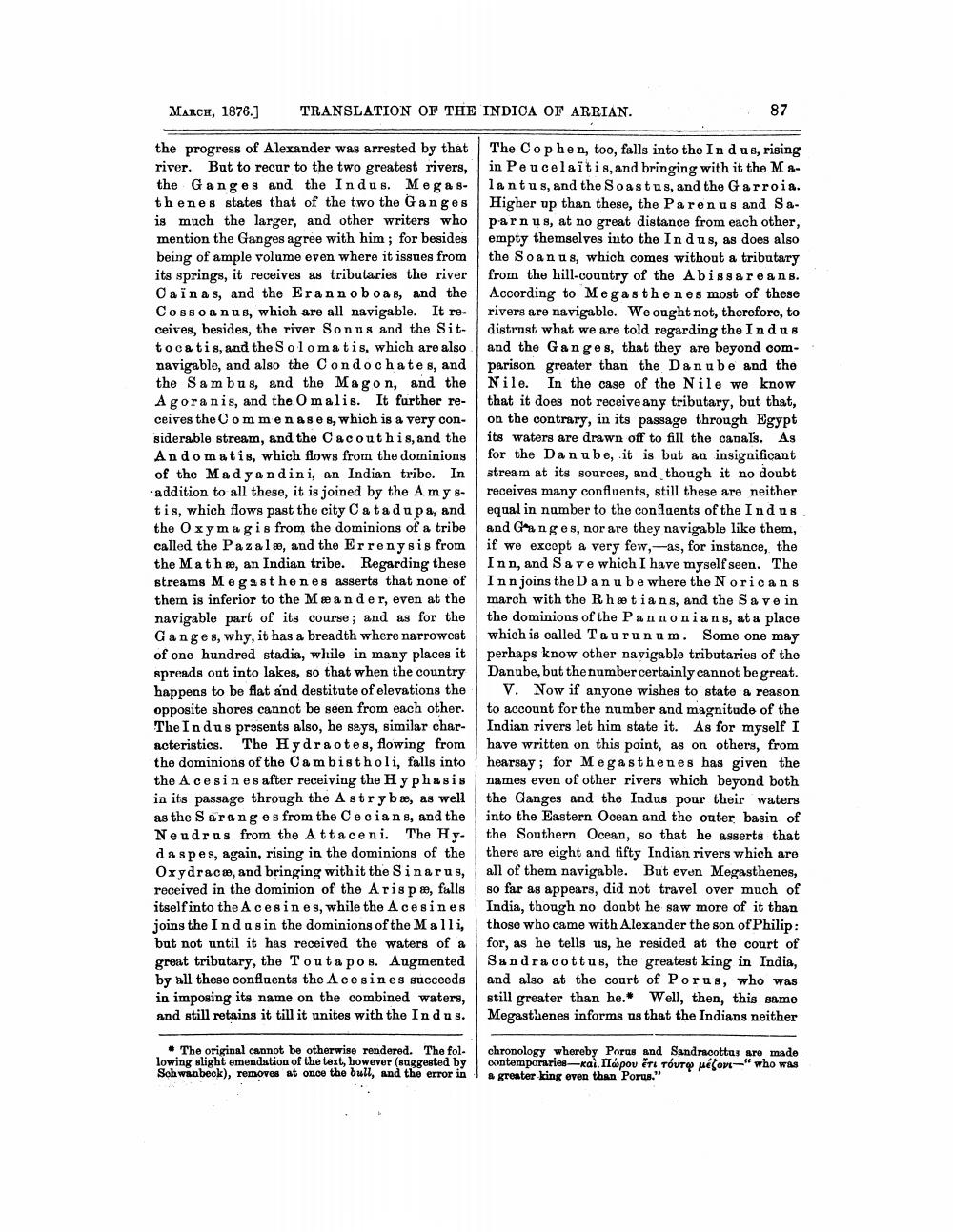________________
MARCH, 1876.]
con
the progress of Alexander was arrested by that river. But to recur to the two greatest rivers, the Ganges and the Indus. Megasthenes states that of the two the Ganges is much the larger, and other writers who mention the Ganges agree with him; for besides being of ample volume even where it issues from its springs, it receives as tributaries the river Cainas, and the Erannoboas, and the Cossoanus, which are all navigable. It receives, besides, the river Sonus and the Sittocatis, and the Solomatis, which are also navigable, and also the Condo chates, and the Sambus, and the Magon, and the Agoranis, and the Omalis. It further receives the Commenases, which is a very cor siderable stream, and the Cacout his, and the Andomatis, which flows from the dominions of the Madyandini, an Indian tribe. In addition to all these, it is joined by the A my s tis, which flows past the city Ca ta dupa, and the Oxymagis from the dominions of a tribe called the Paz ala, and the Errenysis from the Maths, an Indian tribe. Regarding these streams Megasthenes asserts that none of them is inferior to the Meander, even at the navigable part of its course; and as for the Ganges, why, it has a breadth where narrowest of one hundred stadia, while in many places it spreads out into lakes, so that when the country happens to be flat and destitute of elevations the opposite shores cannot be seen from each other. The Indus presents also, he says, similar characteristics. The Hydraotes, flowing from the dominions of the Cambistholi, falls into the Acesines after receiving the Hyphasis in its passage through the Astry be, as well as the Saranges from the Cecians, and the Neudrus from the Attaceni. The Hyda spes, again, rising in the dominions of the Oxydrace, and bringing with it the Sinarus, received in the dominion of the Aris pæ, falls itself into the A c esines, while the Acesines joins the Ind us in the dominions of the Malli, but not until it has received the waters of a great tributary, the Touta pos. Augmented by all these confluents the Acesines succeeds in imposing its name on the combined waters, and still retains it till it unites with the Indus.
TRANSLATION OF THE INDICA OF ARRIAN.
The original cannot be otherwise rendered. The following slight emendation of the text, however (suggested by Schwanbeck), removes at once the bull, and the error in
87
The Cophen, too, falls into the Indus, rising in Peucelaïti s, and bringing with it the M alantus, and the Soastus, and the Garroia. Higher up than these, the Parenus and Saparnus, at no great distance from each other, empty themselves into the Indus, as does also the Soan us, which comes without a tributary from the hill-country of the Abissareans. According to Megasthenes most of these rivers are navigable. We ought not, therefore, to distrust what we are told regarding the Indus and the Ganges, that they are beyond comparison greater than the Danube and the Nile. In the case of the Nile we know that it does not receive any tributary, but that, on the contrary, in its passage through Egypt its waters are drawn off to fill the canals. As for the Danube, it is but an insignificant stream at its sources, and though it no doubt receives many confluents, still these are neither equal in number to the confluents of the Indus and Ganges, nor are they navigable like them, if we except a very few,-as, for instance, the Inn, and Save which I have myself seen. The Inn joins the Danube where the Noricans march with the Rhaetians, and the Save in the dominions of the Pannonians, at a place which is called Taurunum. Some one may perhaps know other navigable tributaries of the Danube, but the number certainly cannot be great.
V. Now if anyone wishes to state a reason to account for the number and magnitude of the Indian rivers let him state it. As for myself I have written on this point, as on others, from hearsay; for Megasthenes has given the names even of other rivers which beyond both the Ganges and the Indus pour their waters into the Eastern Ocean and the outer basin of the Southern Ocean, so that he asserts that there are eight and fifty Indian rivers which are all of them navigable. But even Megasthenes, so far as appears, did not travel over much of India, though no doubt he saw more of it than those who came with Alexander the son of Philip: for, as he tells us, he resided at the court of Sandracottus, the greatest king in India, and also at the court of Porus, who was still greater than he. Well, then, this same Megasthenes informs us that the Indians neither
chronology whereby Porus and Sandracottas are made. cmtemporaries-καὶ Πώρου ἔτι τόυτῳ μέζον--" who was
a greater king even than Porus."




